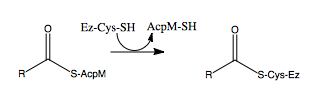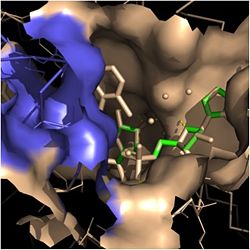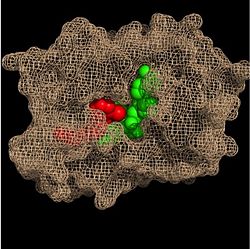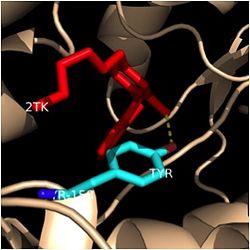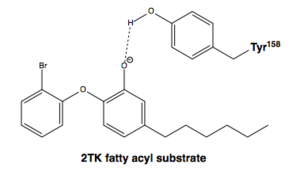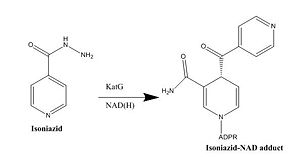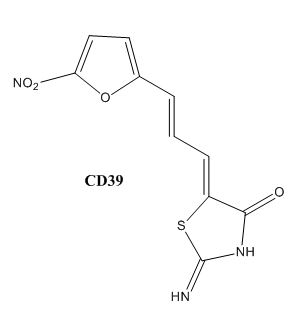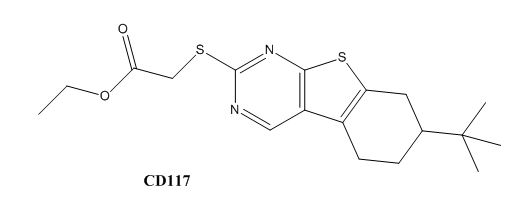Sandbox Reserved 1074
From Proteopedia
| Line 23: | Line 23: | ||
The InhA gene encodes for the InhA protein. InhA catalyzes the NADH-dependent reduction of the ''trans'' double bond between positions C2-C3 of fatty acyl substrates. InhA prefers fatty acyl substrates of C16 or longer, which is consistent of the protein being a member of the FAS-II system. The longer chain length specificity of InhA distinguishes the enzyme from other enoyl-ACP reductase analogues. | The InhA gene encodes for the InhA protein. InhA catalyzes the NADH-dependent reduction of the ''trans'' double bond between positions C2-C3 of fatty acyl substrates. InhA prefers fatty acyl substrates of C16 or longer, which is consistent of the protein being a member of the FAS-II system. The longer chain length specificity of InhA distinguishes the enzyme from other enoyl-ACP reductase analogues. | ||
| - | [[Image:Mechanism-InhA.JPG|thumb|1000px|center|Figure | + | [[Image:Mechanism-InhA.JPG|thumb|1000px|center|Figure 4. Reaction catalyzed by InhA protein <ref name="InhA"/> ]] |
== '''General Structural Information''' == | == '''General Structural Information''' == | ||
| - | [[Image:Fatty Acyl Binding Crevice.jpg|thumb|250px|left|Figure | + | [[Image:Fatty Acyl Binding Crevice.jpg|thumb|250px|left|Figure 5. Fatty Acyl Binding Crevice (substrate binding loop in purple; substrates pictured inside the crevice)]] |
Crystal structures of InhA reveal a <scene name='69/694241/Homotetramer_subunits_labeled/1'>homotetramer</scene> (each subunit featured with a different color) in aqueous solution with separate ligand binding sites in each subunit <ref name="InhA"> Rozwarski, D.A. ''et al.'' (1999). Crystal Structure of the ''Mycobacterium tuberculosis'' Enoyl-ACP Reductase, InhA, in Complex with NAD<sup>+</sup> and a C16 Fatty Acyl Substrate. ''Journal of Biological Chemistry, 274(22),'' 15582-15589. PMID: [http://www.ncbi.nlm.nih.gov/pubmed/10336454 10336454] DOI: [http://www.ncbi.nlm.nih.gov/pubmed/10336454 10.1074/jbc.274.22.15582]</ref>. Each <scene name='69/694241/Monomer_fixed/1'>monomer</scene> subunit is composed of 289 residues and features a typical [http://en.wikipedia.org/wiki/Rossmann_fold Rossmann fold] (<scene name='69/694241/Rossmann_fold_better/1'>Rossmann fold</scene> - β-sheets = light blue; α-helices = dark blue) containing a single NADH binding site. The <scene name='69/694241/Secondary_structure/2'>secondary structure</scene> of InhA is made up of several α-helices (pink), β-sheets (gold), and β-turns (white/blue) <ref name="Phe149"> Bell, A.F. ''et al.''(2007). Evidence from Raman Spectroscopy That InhA , the Mycobacterial Enoyl Reductase, Modulates the Conformation of the NADH Cofactor to Promote Catalysis. ''Journal of the American Chemical Society, 129,'' 6425-6431. DOI: [http://pubs.acs.org/doi/abs/10.1021/ja068219m 10.1021/ja068219m]</ref>. This enzyme also features a fatty acyl binding crevice that accommodates the long-chain fatty acyl substrate needed to synthesize mycolic acid precursors. The <scene name='69/694241/Helices_6and7_final/1'>α-6 and α-7 helices</scene> of the InhA form one side of the fatty acyl binding crevice, referred to as the <scene name='69/694241/Substrate_binding_loopresidues/1'>substrate binding loop</scene> (residues 196-219). One side of this crevice is open and exposed to solvent, which allows the substrates to access the binding pocket of this enzyme. The size of the substrate binding loop is a primary determinant of the ability of InhA to select for fatty acyl chains longer than 16 carbons to successfully produce mycolic acid precursors <ref name="InhA" />. | Crystal structures of InhA reveal a <scene name='69/694241/Homotetramer_subunits_labeled/1'>homotetramer</scene> (each subunit featured with a different color) in aqueous solution with separate ligand binding sites in each subunit <ref name="InhA"> Rozwarski, D.A. ''et al.'' (1999). Crystal Structure of the ''Mycobacterium tuberculosis'' Enoyl-ACP Reductase, InhA, in Complex with NAD<sup>+</sup> and a C16 Fatty Acyl Substrate. ''Journal of Biological Chemistry, 274(22),'' 15582-15589. PMID: [http://www.ncbi.nlm.nih.gov/pubmed/10336454 10336454] DOI: [http://www.ncbi.nlm.nih.gov/pubmed/10336454 10.1074/jbc.274.22.15582]</ref>. Each <scene name='69/694241/Monomer_fixed/1'>monomer</scene> subunit is composed of 289 residues and features a typical [http://en.wikipedia.org/wiki/Rossmann_fold Rossmann fold] (<scene name='69/694241/Rossmann_fold_better/1'>Rossmann fold</scene> - β-sheets = light blue; α-helices = dark blue) containing a single NADH binding site. The <scene name='69/694241/Secondary_structure/2'>secondary structure</scene> of InhA is made up of several α-helices (pink), β-sheets (gold), and β-turns (white/blue) <ref name="Phe149"> Bell, A.F. ''et al.''(2007). Evidence from Raman Spectroscopy That InhA , the Mycobacterial Enoyl Reductase, Modulates the Conformation of the NADH Cofactor to Promote Catalysis. ''Journal of the American Chemical Society, 129,'' 6425-6431. DOI: [http://pubs.acs.org/doi/abs/10.1021/ja068219m 10.1021/ja068219m]</ref>. This enzyme also features a fatty acyl binding crevice that accommodates the long-chain fatty acyl substrate needed to synthesize mycolic acid precursors. The <scene name='69/694241/Helices_6and7_final/1'>α-6 and α-7 helices</scene> of the InhA form one side of the fatty acyl binding crevice, referred to as the <scene name='69/694241/Substrate_binding_loopresidues/1'>substrate binding loop</scene> (residues 196-219). One side of this crevice is open and exposed to solvent, which allows the substrates to access the binding pocket of this enzyme. The size of the substrate binding loop is a primary determinant of the ability of InhA to select for fatty acyl chains longer than 16 carbons to successfully produce mycolic acid precursors <ref name="InhA" />. | ||
| Line 37: | Line 37: | ||
== '''Fatty Acyl Binding Crevice''' == | == '''Fatty Acyl Binding Crevice''' == | ||
| - | Within the fatty acyl binding crevice, the NADH substrate sits on the top shelf of the Rossmann fold, and the fatty acyl substrate sits on top of the NADH substrate. Due to its position within the crevice, the ''trans'' double bond of the fatty acyl substrate is found near the closed end of the crevice and is located directly adjacent to the nicotinamide ring of [http://en.wikipedia.org/wiki/Nicotinamide_adenine_dinucleotide NADH]. [[Image:Binding Pocket - Mesh.jpg|thumb|250px|right|Figure | + | Within the fatty acyl binding crevice, the NADH substrate sits on the top shelf of the Rossmann fold, and the fatty acyl substrate sits on top of the NADH substrate. Due to its position within the crevice, the ''trans'' double bond of the fatty acyl substrate is found near the closed end of the crevice and is located directly adjacent to the nicotinamide ring of [http://en.wikipedia.org/wiki/Nicotinamide_adenine_dinucleotide NADH]. [[Image:Binding Pocket - Mesh.jpg|thumb|250px|right|Figure 6. Substrate Binding Pocket (NADH in green; fatty acyl substrate in red)]] These two molecules interact with each other via hydrogen bonding. The first hydrogen bond occurs between the phosphate oxygen of NADH and the amide nitrogen of the N-acetylcysteamine portion of the fatty acyl substrate. The second hydrogen bond occurs between the 2'-hydroxyl of the nicotinamide ribose of NADH and the thioester carbonyl oxygen of the fatty acyl substrate <ref name="InhA" />. |
==='''Substrate Binding Loop Flexibility''' === | ==='''Substrate Binding Loop Flexibility''' === | ||
| Line 45: | Line 45: | ||
==='''Importance of Tyr-158'''=== | ==='''Importance of Tyr-158'''=== | ||
| - | [[Image:Tyr-158.jpg|thumb|250px|left|Figure | + | [[Image:Tyr-158.jpg|thumb|250px|left|Figure 7. Tyr-158 (light blue) hydrogen bonding to the fatty acyl substrate, 2TK (red)]] One example of an amino acid that is not a part of the substrate binding loop yet interacts with the fatty acyl substrate is Tyr-158. This amino acid is conserved in other enoyl-ACP reductases in both bacteria and plants, so it likely plays an essential role in the function of these specific enzymes. Studies have shown that <scene name='69/694241/Tyr158_2tk/1'>Tyr-158</scene> forms the only direct hydrogen bond that exists between the InhA protein and the fatty acyl substrate. This hydrogen bond occurs between the hydroxyl oxygen on the side chain of Tyr-158 and the thioester carbonyl oxygen of the fatty acyl substrate. Consequently, the Tyr-158 residue acts to stabilize the enolate intermediate that forms during the hydride transfer reaction <ref name="InhA" />. |
| - | [[Image:Tyr-158_and_2TK.png|thumb|300 px|center|Figure | + | [[Image:Tyr-158_and_2TK.png|thumb|300 px|center|Figure 8. The side chain hydroxyl of Tyr-158 stabilizes the enolate intermediate of the fatty acyl substrate (2TK) <ref name=”Tyr-158”> Li, H.J. “et al.” (2014). A Structural and Energetic Model for the Slow-Onset Inhibition of the “Mycobacterium tuberculosis“ Enoyl-ACP Reductase InhA. “ACS Chemical Biology 9,” 986-993. PMID: [http://pubs.acs.org/doi/pdf/10.1021/cb400896g 24527857] </ref>.]] |
== '''Catalytic Triad''' == | == '''Catalytic Triad''' == | ||
| Line 55: | Line 55: | ||
== '''Clinical Applications''' == | == '''Clinical Applications''' == | ||
| - | [[Image:Isoniazid.JPG|thumb|300px|right|Figure | + | [[Image:Isoniazid.JPG|thumb|300px|right|Figure 9. Isoniazid Mechanism of Action <ref name="InhA"/> ]] |
=== Isoniazid === | === Isoniazid === | ||
| Line 64: | Line 64: | ||
Drug resistance of ''M. tuberculosis'' has become a huge problem for the development of antibiotics. A drug screen of potential inhibitors of InhA (300 compounds) was composed of inhibitors of the [http://en.wikipedia.org/wiki/Plasmodium_falciparum ''Plasmodium falciparum''] enoyl-reductase. The enoyl reductases of both bacteria have limited similarities; however, two compounds, CD39 and CD117, showed activity against drug-susceptible ''M. tuberculosis''. More importantly, both compounds showed activity against drug-resistant and multi-drug resistant TB. Treatment of the bacterium with the compounds resulted in the inhibition of mycolic acid and long-chain fatty acid biosynthesis, indicating that these compounds act against enzymes of both the FAS-I and FAS-II system. The benefit of the compounds having multiple targets is the reduced development of drug resistance, which is the disadvantage of isoniazid. The essential chemical groups that lead to the antimycobacterial properties of the compounds include a [http://en.wikipedia.org/wiki/Thioacetic_acid thioacetate] group and a [http://en.wikipedia.org/wiki/Butyl t-butyl] group <ref name="other inhibitors"> Vilchèze, C. ''et al.'' (2011). Novel Inhibitors of InhA Efficiently Kill Mycobacterium tuberculosis under Aerobic and Anaerobic Conditions. ''Antimicrobial Agents and Chemotherapy, 55(8),'' 3889-3898. DOI: [http://aac.asm.org/content/55/8/3889.full#T1 10.1128/AAC.00266-11]</ref>. | Drug resistance of ''M. tuberculosis'' has become a huge problem for the development of antibiotics. A drug screen of potential inhibitors of InhA (300 compounds) was composed of inhibitors of the [http://en.wikipedia.org/wiki/Plasmodium_falciparum ''Plasmodium falciparum''] enoyl-reductase. The enoyl reductases of both bacteria have limited similarities; however, two compounds, CD39 and CD117, showed activity against drug-susceptible ''M. tuberculosis''. More importantly, both compounds showed activity against drug-resistant and multi-drug resistant TB. Treatment of the bacterium with the compounds resulted in the inhibition of mycolic acid and long-chain fatty acid biosynthesis, indicating that these compounds act against enzymes of both the FAS-I and FAS-II system. The benefit of the compounds having multiple targets is the reduced development of drug resistance, which is the disadvantage of isoniazid. The essential chemical groups that lead to the antimycobacterial properties of the compounds include a [http://en.wikipedia.org/wiki/Thioacetic_acid thioacetate] group and a [http://en.wikipedia.org/wiki/Butyl t-butyl] group <ref name="other inhibitors"> Vilchèze, C. ''et al.'' (2011). Novel Inhibitors of InhA Efficiently Kill Mycobacterium tuberculosis under Aerobic and Anaerobic Conditions. ''Antimicrobial Agents and Chemotherapy, 55(8),'' 3889-3898. DOI: [http://aac.asm.org/content/55/8/3889.full#T1 10.1128/AAC.00266-11]</ref>. | ||
| - | [[Image:CD39.JPG|thumb|500px|left|Figure | + | [[Image:CD39.JPG|thumb|500px|left|Figure 10. CD39 Structure <ref name="other inhibitors"/>]] [[Image:CD117.JPG|thumb|600 px|center|Figure 11. CD117 Structure <ref name="other inhibitors"/>]] |
Revision as of 21:52, 15 April 2015
| This Sandbox is Reserved from 02/09/2015, through 05/31/2016 for use in the course "CH462: Biochemistry 2" taught by Geoffrey C. Hoops at the Butler University. This reservation includes Sandbox Reserved 1051 through Sandbox Reserved 1080. |
To get started:
More help: Help:Editing |
Contents |
Enoyl-ACP Reductase InhA from Mycobacterium tuberculosis
| |||||||||||
References
- ↑ 1.0 1.1 1.2 1.3 Bell, A.F. et al.(2007). Evidence from Raman Spectroscopy That InhA , the Mycobacterial Enoyl Reductase, Modulates the Conformation of the NADH Cofactor to Promote Catalysis. Journal of the American Chemical Society, 129, 6425-6431. DOI: 10.1021/ja068219m
- ↑ 2.0 2.1 2.2 2.3 2.4 Bhatt, A. et al. (2007). The Mycobacterium tuberculosis FAS-II condensing enzymes: their role in mycolic acid biosynthesis, acid-fastness, pathogenesis and in future drug development. Journal of Molecular Microbiology, 64(6), 1442-1454. PMID: 17555433 DOI: 10.1111/j.1365-2958.2007.05761.x
- ↑ Marrakchi, Hedia, et al. (2000). InhA, a target of the antituberculous drug isoniazid, is involved in a mycobacterial fatty acid elongation system, FAS-II. Journal of Microbiology, 146, 289-296. PMID: 10708367
- ↑ 4.00 4.01 4.02 4.03 4.04 4.05 4.06 4.07 4.08 4.09 4.10 4.11 Rozwarski, D.A. et al. (1999). Crystal Structure of the Mycobacterium tuberculosis Enoyl-ACP Reductase, InhA, in Complex with NAD+ and a C16 Fatty Acyl Substrate. Journal of Biological Chemistry, 274(22), 15582-15589. PMID: 10336454 DOI: 10.1074/jbc.274.22.15582
- ↑ Li, H.J. “et al.” (2014). A Structural and Energetic Model for the Slow-Onset Inhibition of the “Mycobacterium tuberculosis“ Enoyl-ACP Reductase InhA. “ACS Chemical Biology 9,” 986-993. PMID: 24527857
- ↑ Kruh, N. “et al.” (2007). Probing mechanisms of resistance to the tuberculosis drug isoniazid: Conformational changes caused by inhibition of InhA, the enoyl reductase from Mycobacterium tuberculosis. Protein Sci, 16(8), 1617-1627. PMID: 17600151
- ↑ 7.0 7.1 7.2 Vilchèze, C. et al. (2011). Novel Inhibitors of InhA Efficiently Kill Mycobacterium tuberculosis under Aerobic and Anaerobic Conditions. Antimicrobial Agents and Chemotherapy, 55(8), 3889-3898. DOI: 10.1128/AAC.00266-11
Student Contributors
- Arielle Russell
- Mackenzie A. Smith
Similar Proteopedia Pages
Enoyl-Acyl-Carrier Protein Reductase
Additional 3D Structures of Enoyl-ACP Reductase InhA
3oew, 2x22, 2x23, 1eny, 1enz, 4dqu, 4dre - MtENR+NAD; 3of2, 4dti - MtENR(mutant)+NAD; 2pr2, 2idz, 2h9i - MtENR+INH-NAPD; 2aq8 - MtENR+NADH; 2aqh, 2aqi, 2aqk, 3oey - MtENR(mutant)+NADH; 2ntj - MtENR+PTH-NAD; 2ie0, 2ieb, 2nv6, 1zid - MtENR(mutant)+INH-NAPD; 3fne, 3fnf, 3fng, 3fnh, 2b35, 1p45 - MtENR+NAD+TCI; 2b36, 2b37, 4ohu, 4oim, 4oyr - MtENR+NAD+phenoxyphenol derivative; 2nsd - MtENR+NAD+piperidine derivative; 2h7l, 2h7m, 2h7n, 2h7p, 4u0j, 4tzt, 4tzk, 4trj, 4u0k - MtENR+NAD+pyrrolidine derivative; 4cod, 4bqp, 4bqr, 4bge, 4bii, 4oxk, 4oxn, 4oxy, 4r9r, 4r9s - MtENR+NAD + inhibitor; 4bgi - MtENR (mutant)+NAD+inhibitor; 1p44 - MtENR+NAD+indole derivative; 1bvr - MtENR+NAD+fatty-acyl substrate
